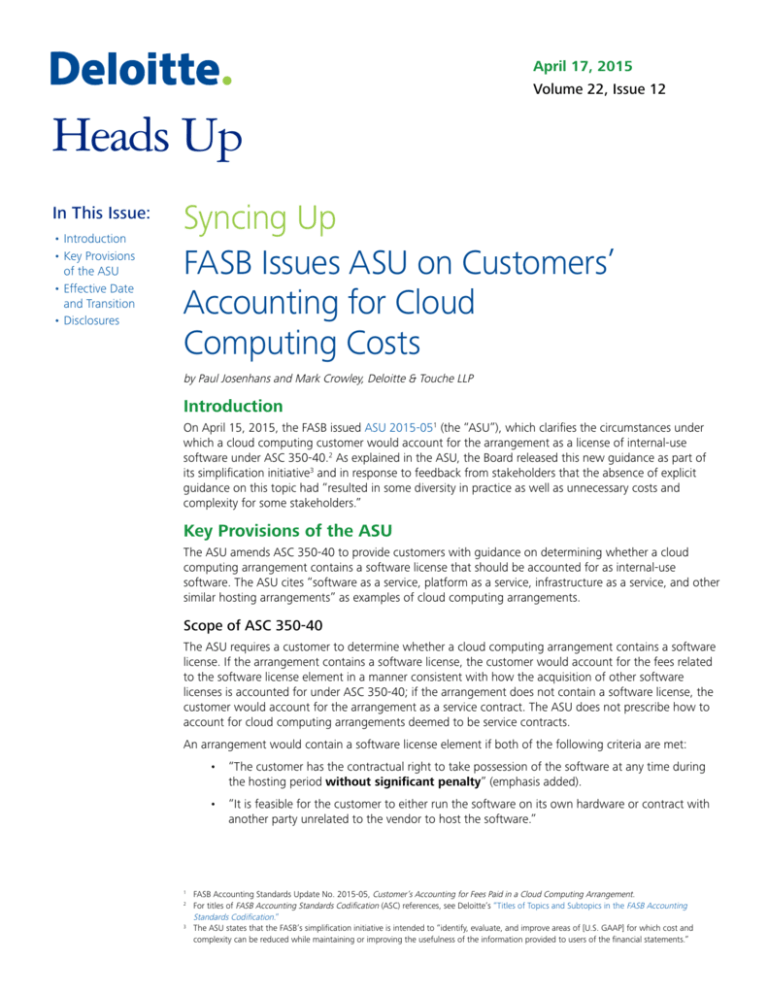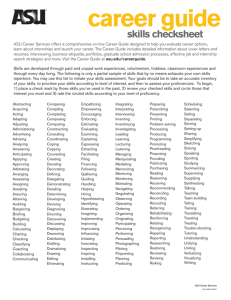
April 17, 2015
Volume 22, Issue 12
Heads Up
In This Issue:
•Introduction
•Key Provisions
of the ASU
•Effective Date
and Transition
•Disclosures
Syncing Up
FASB Issues ASU on Customers’
Accounting for Cloud
Computing Costs
by Paul Josenhans and Mark Crowley, Deloitte & Touche LLP
Introduction
On April 15, 2015, the FASB issued ASU 2015-051 (the “ASU”), which clarifies the circumstances under
which a cloud computing customer would account for the arrangement as a license of internal-use
software under ASC 350-40.2 As explained in the ASU, the Board released this new guidance as part of
its simplification initiative3 and in response to feedback from stakeholders that the absence of explicit
guidance on this topic had “resulted in some diversity in practice as well as unnecessary costs and
complexity for some stakeholders.”
Key Provisions of the ASU
The ASU amends ASC 350-40 to provide customers with guidance on determining whether a cloud
computing arrangement contains a software license that should be accounted for as internal-use
software. The ASU cites “software as a service, platform as a service, infrastructure as a service, and other
similar hosting arrangements” as examples of cloud computing arrangements.
Scope of ASC 350-40
The ASU requires a customer to determine whether a cloud computing arrangement contains a software
license. If the arrangement contains a software license, the customer would account for the fees related
to the software license element in a manner consistent with how the acquisition of other software
licenses is accounted for under ASC 350-40; if the arrangement does not contain a software license, the
customer would account for the arrangement as a service contract. The ASU does not prescribe how to
account for cloud computing arrangements deemed to be service contracts.
An arrangement would contain a software license element if both of the following criteria are met:
• “The customer has the contractual right to take possession of the software at any time during
the hosting period without significant penalty” (emphasis added).
• “It is feasible for the customer to either run the software on its own hardware or contract with
another party unrelated to the vendor to host the software.”
FASB Accounting Standards Update No. 2015-05, Customer’s Accounting for Fees Paid in a Cloud Computing Arrangement.
For titles of FASB Accounting Standards Codification (ASC) references, see Deloitte’s “Titles of Topics and Subtopics in the FASB Accounting
Standards Codification.”
3
The ASU states that the FASB’s simplification initiative is intended to “identify, evaluate, and improve areas of [U.S. GAAP] for which cost and
complexity can be reduced while maintaining or improving the usefulness of the information provided to users of the financial statements.”
1
2
In a manner consistent with ASC 985-605-55-122, the ASU describes “without significant penalty”
as containing two distinct concepts: (1) the “ability to take delivery of the software without incurring
significant cost” and (2) the “ability to use the software separately without a significant diminution in
utility or value.”
The ASU also uses the term “software license element.” Although this term is not defined, the ASU’s
Basis for Conclusions acknowledges that an arrangement may include a software license as well as a
promise to provide services. In such cases, “the customer should allocate the contract consideration
between the license(s) and the service element(s).”
Editor’s Note: Under the ASU, a customer would perform the same assessment that cloud
computing vendors currently perform to determine whether an arrangement includes the sale of a
software license that is subject to the software revenue recognition requirements of ASC 985-605.
The Board acknowledged that these criteria are already applied and understood in current practice;
accordingly, it intentionally aligned the customer’s assessment of whether the arrangement
contains a software license with that performed by the vendor. The ASU’s Basis for Conclusions
further states that the ASU is not intended to change U.S. GAAP for cloud computing vendors.
Applying ASC 350-40 to Arrangements Within Its Scope
In addition to amending the scope of ASC 350-40, the ASU amends the accounting for arrangements
within the subtopic’s scope. Specifically, the ASU supersedes the requirement in ASC 350-40 to
determine the accounting for a software license by analogy to the lease classification test.4 Under this
requirement, the software license would have been accounted for either as a capitalized asset if similar
to a capital lease or as an executory contract if similar to an operating lease. Although the Board had
originally proposed the superseding amendment in its 2013 revised exposure draft on leases, it decided
to include the change in this ASU because “the accounting for software licenses should not be different
from the accounting for other licenses of intangible assets.” As a result, entities with software licenses
within the scope of ASC 350-40 would account for them in a manner consistent with the accounting for
other licenses of intangible assets.
Editor’s Note: In response to the Board’s initial proposal to clarify customers’ accounting for fees
paid in cloud computing arrangements, many stakeholders requested guidance on accounting for
up-front costs, such as costs related to implementation and set-up activities. The Board ultimately
decided not to expand the scope of the cloud computing project to address such fees, concluding
that the accounting for up-front costs related to service contracts is a much broader issue than
could be addressed within the scope of this project. However, the ASU’s Basis for Conclusions
notes that “to the extent a cloud computing arrangement transfers a software license,
[ASC] 350-40 provides guidance on how to account for costs such as those resulting from training,
data capture, and conversion activities.”
Entities that incur up-front costs in cloud computing arrangements accounted for as service
contracts will need to continue to use judgment in accounting for such payments. For example,
entities might look to Concepts Statement 65 when evaluating whether up-front fees and other
costs related to a cloud computing arrangement give rise to an asset.6
Effective Date and Transition
For public business entities, the ASU is effective for annual periods (and interim periods therein)
beginning after December 15, 2015; for all other entities, the ASU is effective for annual periods
beginning after December 15, 2015, and interim periods in annual periods beginning after
December 15, 2016. Early adoption is permitted. Entities may adopt the guidance (1) retrospectively or
(2) prospectively to arrangements entered into, or materially modified, after the effective date.
ASC 350-40-25-16 currently states, “Though [ASC] 840-10 excludes licensing agreements from its scope, entities shall analogize to that Subtopic
when determining the asset acquired in a software licensing arrangement.”
5
FASB Concepts Statement No. 6, Elements of Financial Statements.
6
Concepts Statement 6 defines assets as “probable future economic benefits obtained or controlled by a particular entity as a result of past
transactions or events.”
4
2
Disclosures
Depending on the method of transition elected, public business entities are required to provide the
disclosures indicated in the table below.
Prospective Transition
Retrospective Transition
Public business entities that elect prospective transition are
required to disclose the following information in the first
interim period and annual period after the effective date:
Public business entities that elect retrospective transition are
required to disclose the following information in the first
annual period after the entity’s adoption date and in the
interim periods within the first annual period:
• “The nature of and reason for the change in accounting
principle.”
• “The transition method.”
• “A qualitative description of the financial statement line
items affected by the change.”
• “The nature of and reason for the change in accounting
principle.”
• “The transition method.”
• “A description of the prior-period information that has
been retrospectively adjusted.”
• “The effect of the change on income from continuing
operations, net income (or other appropriate captions
of changes in the applicable net assets or performance
indicator), any other affected financial statement line
item(s), and any affected per-share amounts for the
current period and any prior periods, retrospectively
adjusted.”
• “The cumulative effect of the change on retained
earnings or other components of equity or net assets in
the statement of financial position as of the beginning of
the earliest period presented.”
All other entities are also required to disclose the information above (as applicable to the transition
method elected), except that interim disclosures in the first annual period after the entity’s adoption date
generally do not apply.
3
Subscriptions
If you wish to receive Heads Up and other accounting publications issued by Deloitte’s Accounting Standards and Communications
Group, please register at www.deloitte.com/us/accounting/subscriptions.
Dbriefs for Financial Executives
We invite you to participate in Dbriefs, Deloitte’s webcast series that delivers practical strategies you need to stay on top of
important issues. Gain access to valuable ideas and critical information from webcasts in the “Financial Executives” series on the
following topics:
• Business strategy and tax.
• Financial reporting for taxes.
• Driving enterprise value.
• Governance, risk, and compliance.
• Financial reporting.
•Technology.
• Transactions and business events.
Dbriefs also provides a convenient and flexible way to earn CPE credit — right at your desk. Subscribe to Dbriefs to receive
notifications about future webcasts at www.deloitte.com/us/dbriefs.
Registration is available for this upcoming Dbriefs webcast. Use the link below to register:
• Preventing and Detecting Financial Crime: The Example of Wire Transfer Fraud (April 30, 2 p.m. (EDT)).
Technical Library and US GAAP Plus
Deloitte makes available, on a subscription basis, access to its online library of accounting and financial disclosure literature. Called
Technical Library: The Deloitte Accounting Research Tool, the library includes material from the FASB, EITF, AICPA, PCAOB, IASB,
and SEC, in addition to Deloitte’s own accounting and SEC manuals and other interpretive accounting and SEC guidance.
Updated every business day, Technical Library has an intuitive design and navigation system that, together with its powerful
search features, enable users to quickly locate information anytime, from any computer. Technical Library subscribers also receive
Technically Speaking, the weekly publication that highlights recent additions to the library. For more information, including
subscription details and an online demonstration, visit www.deloitte.com/us/techlibrary.
In addition, be sure to visit US GAAP Plus, our free Web site that features accounting news, information, and publications with a
U.S. GAAP focus. It contains articles on FASB activities and updates to the FASB Accounting Standards Codification™ as well as
developments of other U.S. and international standard setters and regulators, such as the PCAOB, AICPA, SEC, IASB, and
IFRS Interpretations Committee. Check it out today!
Heads Up is prepared by the National Office Accounting Standards and Communications Group of Deloitte
as developments warrant. This publication contains general information only and Deloitte is not, by means of
this publication, rendering accounting, business, financial, investment, legal, tax, or other professional advice
or services. This publication is not a substitute for such professional advice or services, nor should it be used
as a basis for any decision or action that may affect your business. Before making any decision or taking any
action that may affect your business, you should consult a qualified professional advisor.
Deloitte shall not be responsible for any loss sustained by any person who relies on this publication.
As used in this document, “Deloitte” means Deloitte & Touche LLP, a subsidiary of Deloitte LLP. Please see
www.deloitte.com/us/about for a detailed description of the legal structure of Deloitte LLP and its subsidiaries.
Certain services may not be available to attest clients under the rules and regulations of public accounting.
Copyright © 2015 Deloitte Development LLC. All rights reserved.
Member of Deloitte Touche Tohmatsu Limited.





